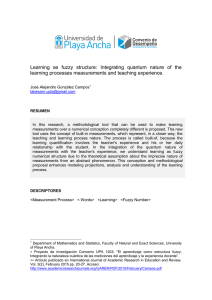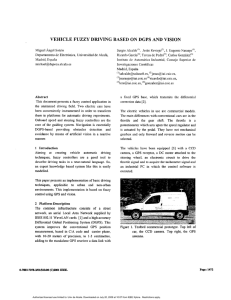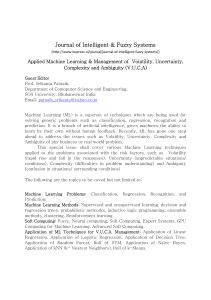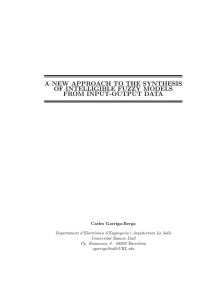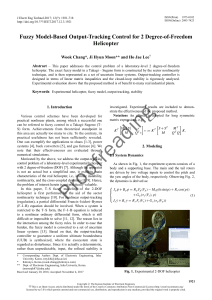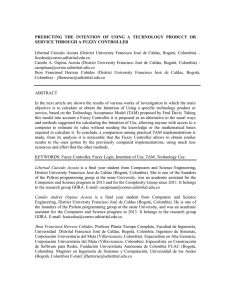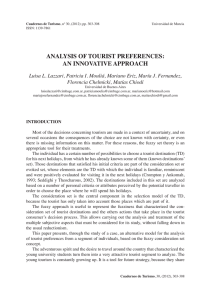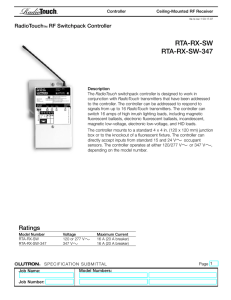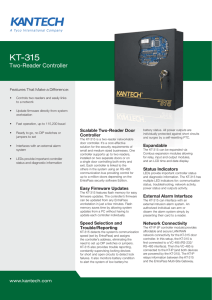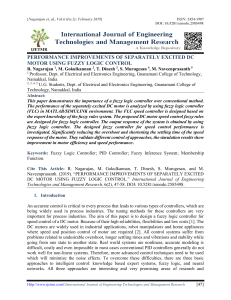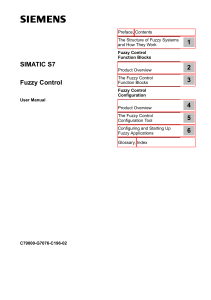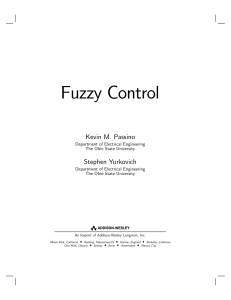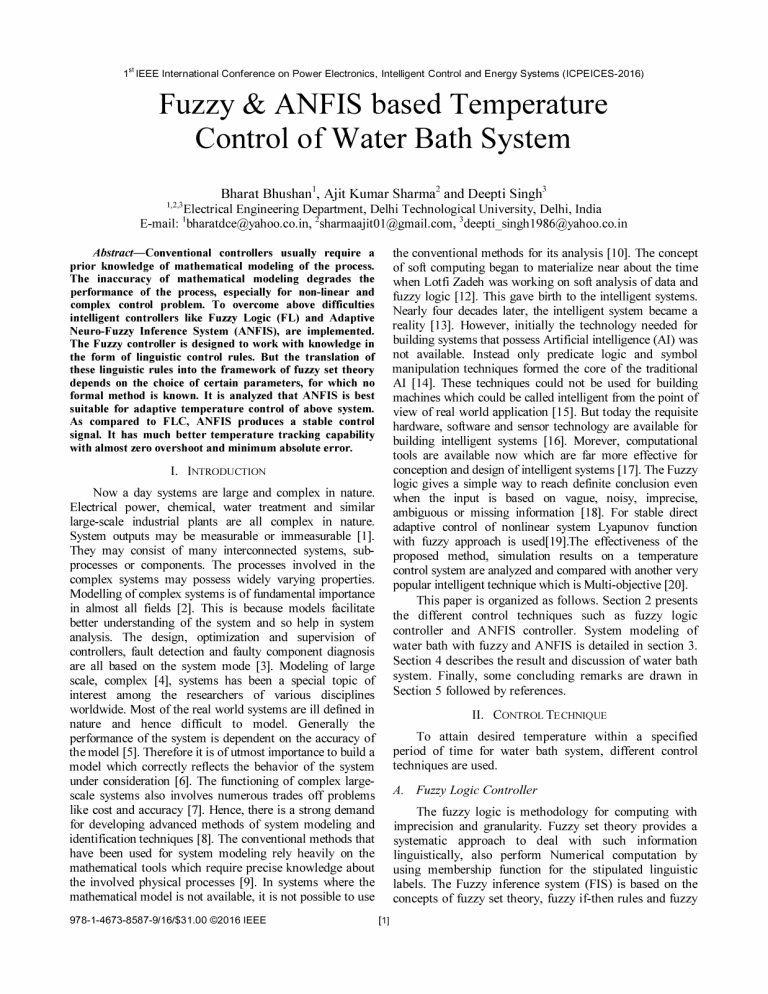
t 1s IEEE International Conference on Power Electronics, Intelligent Control and Energy Systems (ICPEICES-2016) Fuzzy & ANFIS based Temperature Control ofWater Bath System Bharat Bhushanl, Ajit Kumar Sharma2 and Deepti Singh3 1,2,3Electrical Engineering Department, Delhi Technological University, Delhi, India E-mail: [email protected]. [email protected][email protected]. in the conventional methods for its analysis [10]. The concept of soft computing began to materialize near about the time when Lotfi Zadeh was working on soft analysis of data and fuzzy logic [12]. This gave birth to the intelligent systems. Nearly four decades later, the intelligent system became a reality [13]. However, initially the technology needed for building systems that possess Artificial intelligence (AI) was not available. Instead only predicate logic and symbol manipulation techniques formed the core of the traditional AI [14]. These techniques could not be used for building machines which could be called intelligent from the point of view of real world application [15]. But today the requisite hardware, software and sensor technology are available for building intelligent systems [16]. Morever, computational tools are available now which are far more effective for conception and design of intelligent systems [17]. The Fuzzy logic gives a simple way to reach definite conclusion even when the input is based on vague, noisy, imprecise, ambiguous or missing information [18]. For stable direct adaptive control of nonlinear system Lyapunov function with fuzzy approach is used[19].The effectiveness of the proposed method, simulation results on a temperature control system are analyzed and compared with another very popular intelligent technique which is Multi-objective [20]. This paper is organized as folIows. Section 2 presents the different control techniques such as fuzzy logic controller and ANFIS controller. System modeling of water bath with fuzzy and ANFIS is detailed in section 3. Section 4 describes the result and discussion of water bath system. Finally, some concluding remarks are drawn in Section 5 followed by references. Abstract-Conventional controllers usually require a prior knowledge of mathematical modeling of the process. The inaccuracy of mathematical modeling degrades the performance of the process, especially for non-linear and complex control problem. To overcome above difficulties intelligent controllers like Fuzzy Logic (FL) and Adaptive Neuro-Fuzzy Inference System (ANFIS), are implemented. The Fuzzy controller is designed to work with knowledge in the form of linguistic control rules. But the translation of these linguistic rules into the framework of fuzzy set theory depends on the choice of certain parameters, for which no formal method is known. It is analyzed that ANFIS is best suitable for adaptive temperature control of above system. As compared to FLC, ANFIS produces a stable control signal. It has much better temperature tracking capability with almost zero overshoot and minimum absolute error. I. INTRODUCTION Now a day systems are large and complex in nature. Electrical power, chemical, water treatment and similar large-scale industrial plants are all complex in nature. System outputs may be measurable or immeasurable [1]. They may consist of many interconnected systems, sub­ processes or components. The processes involved in the complex systems may possess widely varying properties. Modelling of complex systems is of fundamental importance in almost all fields [2]. This is because models facilitate better understanding of the system and so help in system analysis. The design, optimization and supervision of controllers, fault detection and fuulty component diagnosis are all based on the system mode [3]. Modeling of large scale, complex [4], systems has been a special topic of interest among the researchers of various disciplines worldwide. Most of the real world systems are ill defined in nature and hence difficult to model. Generally the performance of the system is dependent on the accuracy of the model [5]. Therefore it is of utmost importance to build a model which correctly retlects the behavior of the system under consideration [6]. The functioning of complex large­ scale systems also involves numerous trades off problems like cost and accuracy [7]. Hence, there is a strong demand for developing advanced methods of system modeling and identification techniques [8]. The conventional methods that have been used for system modeling rely heavily on the mathematical tools which require precise knowledge about the involved physical processes [9]. In systems where the mathematical model is not available, it is not possible to use 978-1-4673-8587-9/16/$31.00 ©2016 IEEE 11. CONTROL TECHNIQUE To attain desired temperature within a specified period of time for water bath system, different control techniques are used. A. Fuzzy Logic Controller The fuzzy logic is methodology for computing with imprecision and granularity. Fuzzy set theory provides a systematic approach to deal with such information linguistically, also perform Numerical computation by using membership function for the stipulated linguistic labels. The Fuzzy inference system (FIS) is based on the concepts of fuzzy set theory, fuzzy if-then rules and fuzzy [1] t 1s IEEE International Conference on Power Electronics. Intelligent Control and Energy Systems (ICPEICES-2016) y(k + 1) reasoning. The framing of the fuzzy if-then rules forms the key component in FIS. FIS is a very popular technique and has been widely applied in different fields like data c1assification, automatic control, expert system, decision making, robotics, time series analysis, pattern c1assification, system Identification etc. The basic structure of a fuzzy inference system consists of three principal components viz a rule base comprising of the selected fuzzy rules, a database defining the membership functions of the fuzzy rules, and a reasoning mechanism which performs a fuzzy reasoning inference with respect to the rules so as to derive a reasonable output or conclusion. B. Where L:oycr4 ß(l e(-aT) = :..._-­ ....:.. - a Fuuy CCIII U'Qlkr WIll 1 Fig. 2: Fuzzy Control Model for Water-Bath System B. Water Bath Temperature Control using ANFIS The learning is required in order to fine-tune the parameters of the membership function as weil as the parameters of defuzzification. Figure (2) has shown the learning phase of ANFIS, where water bath temperature system is to be controlled. And that the learning of ANFIS is based on error back propagation as weIl. One of the major features of Neural Network (NN) is its learning capability. 'fIild2 x y t t Fig. I: Architecture of ANFIS Controller SYSTEM MODELLING Water-Bath temperature control is one of the most important and widely used applications of non-linear control system in process control industry. A. e(-aT) The parameters of the plant are sets as a= IxlO-4, ß=8.7xlO-3, 1ZI=40 and YO = 250 C. The plant input u (k) is lirnited to between 0 and 5 volts. The sampling period, T, is set as 25 seconds. The goal is to design a fuzzy controller that will control the water temperature to follow a reference profile as c10sely as possible. This reference profile is 350 C for 0�t�I20 minutes and 800 C for 120�t�I80 minutes. The input variables for this controller are chosen as e (k), de (k) where e (k) is the performance error indicating the error between the desire output and the actually output. The de (k) is the change of the error. The output of the controller is the voltage that lirnited to between 0 to 5 volts. A s shown in fig (1) system used two input variables error 'E' change of error 'DE' and one output variable 'U' . The computational structure of fuzzy logic control scheme is composed of fuzzification, inference engine and defuzzification. The input to the fuzzy controller is error 'Ek' and the change in error 'DEk' is computed from the reference output 'Uk' based on error and change in error. f III. = (1) La�rS 1 1 a(T) b(T) ANFIS is a hybrid system of fuzzy inference and neural network architecture. A neuro-fuzzy system describes a fuzzy-rule based model using an N N-like structure (i.e. involving nodes and links). A neuro-fuzzy system differs from an NN in four major ways. Firstly, the nodes and link in a neuro-fuzzy system usually are comprehensible because they each correspond to a specific component in fuzzy system. Secondly connection between nodes in a neuro-fuzzy system retlects the rule structure of the system. Thirdly second layer node are connected to only two nodes from the first layer, each one of which describes a condition about an input variable. The nodes in the second layer thus perform the "AND" (conjunction) operator in fuzzy rules third. Finally the nodes in different layer of neuro-fuzzy system typically perform different operations. So a neuro-fuzzy system typically has more layers than neural networks. Layer3 b(T)u(k) a(T)y(k) + l+exp (O.5y(k)-y) + (1 - a(T))Yo and ANFIS Controller l..a)'crl = yLk) Water Bath Temperature Control using Fuzzy Logic Control In this demonstration, water bath plant for temperature control of fuzzy logic controller is described by: Fig. 3: Learning Phase of ANFIS [2] z' t 1s IEEE International Conference on Power Electronics. Intelligent Control and Energy Systems (ICPEICES-2016) A fter the learning phase is finished, the trained ANFIS is then to be used as a controller for the plant, shown in Fig. (3) �(k) 3 . .. u u .. . . u . . ' � i'!. · · ........: . .. � . . . .. . .. � . 10 60 sampling To design an ANFIS controller for the temperature control of described module. It is implemented by using the direct inverse control strategy, and training data is obtained by imposing random input voltages to the water bath system and record corresponding temperature. The ANFIS is then trained to identify the inverse model of the water bath system using the gathered training data to start the ANFIS training, where FIS matrix is required that specifies the structure and initial parameters of the FIS for learning the given number and types of membership functions. 80 time step 100 120 Kr T=25 seconds 140 160 180 Fig. 6: Controlled Output ofFuzzy Logic Gaussian Membership Function B. Gaussian Membership Function (ANFIS) (2) A ES= sum (abs (ref-y)) =367.3556 SIMULATION REsULTS & DISCUSSION Water-Bath temperature control is widely used applications of non-linear control system in process control industry. The main objective is to develop a Water-Bath system, to attain desired temperature within a specified period of time to avoid the overshoot and absolute error, with better temperature tracking capability, To overcome above difficulties intelligent controllers, Fuzzy Logic (FL) and A daptive Neuro-Fuzzy Inference System (ANFIS) based temperature control of water bath system is simulated for different membership functions. Results of Water bath Temperature Control using Fuzzy Logic Control & ANFIS for different membership: Sampling Time Step KT T=25 seconds Fig. 7: Controlled Output of ANFIS for Gauss Membership Function In figure (7) the graph shows the output of the controller is the voltage that lirnited to between 0 to 5 volts. c. Trapezoidal Membership Function (Fuzzy Logic) 1 ,.. I IA) 'iiiiiif2i Ty,.. Tv.,.. P.. ,....... .....p ... R..n_ Gaussian Membership Function (Fuzzy Logic) 1" '1 I� I··· .._m ... . .. In the figure (6) the graph shows the actual output is reach approximate to the reference signal. The output of the controller is the voltage that lirnited to between 0 to 5 volts. Sampling time t is for 25 seconds. I!J '" .. . 0 20 t/' T u '---" u ----._ .-; :' , r " " :�.11"! '----,. 1 .,'/".-!_-"' .. . . . : Fig. 4: Controller for the Plant A. ... ,. i 50 � 40 x., (k+l) ' 60 �(k+l) L/ reference signal--actual output.control S i gn .'_ u �� , u , u u ' -,-_ -, 70 ,------, IV. u 80 U _ e... -----.J I Fig. 8: Trapezoidal Membership Function ofFuzzy Logic 80 .. .. . ., .. .. .. , 60 _utt" i= l,/ _t 3 0 .' ' .; . . .... ......ct) G:::::::::;::::! u /<_ .. u ....... J . ; . . . . . . . . . . . . . . . . . .� 20 10 , . ,---, . . .. .......F- reference signal--actual output.contro! signa!_ ................. , . . .. . . . .. .. . ... .. . . 70 M .. rn �rshi p Function Editor: fis2 Curn.nt M"rnb."$hip Function (click on MF 10 "......... (_0_.5_0.0 ........ 0_0 .....70_ · "1 -----.J H.. . . : .. 60 samp!ing : . u 80 time step 100 120 KT T=25 $econds .. : .. j .. . ... .. . . .. . . . . . - .., : .. .. u h : ....F----\ . .. 140 u : ] : . .. .. . .; .. 160 .. 180 Fig. 9: Controlled Output ofFuzzy Logic Controller for Trapezoidal Membership Function Fig. 5: Gaussian Membership Function ofFuzzy Logic [3] t 1s IEEE International Conference on Power Electronics. Intelligent Control and Energy Systems (ICPEICES-2016) In the figure (9) the graph shows the absolute error sum for the trapezoidal function is coming much larger than that for Gaussian membership function. smaller than trapezoidal fimction (501.72) but coming much larger than that for Gaussian membership function (429.07). D. F. Trapezoidal Membership Function (ANFIS) Gbell Membership Function (ANFIS) A ES= sum (abs (ref-y)) =368. 9700 A ES= sum (abs (ref-y)) =370. 2979 (3) Reference Signat-- Actual Output. Control SignaL Reference Signal-- Actual Output. Control SignaL 80 c----� 70 Sampling Time Step Kr T=25 seconds Sampling Time Step Fig. 10: Controlled Output of ANFIS Controller for Trapezoidal Membership Function m Gbellmf (Fuzzy Logic) M"" .... ber" h i p I Function Editor: gbell 1 N NS NM ZR PS � In figure (13) the graph shows the absolute error sum for the Anfis, gbellmf (370.9652) is coming bit larger than Gaussian membership function (367.3556), trapezoidal membership function(368.9700). I 13 !5f'E/ ..... T=25 seconds Fig. 13: Controlled Output of AN FIS Controller for Gbell Membership Function In the figure (10) the graph shows the absolute error sum for the Anfis trapmf (368.9700) is coming bit larger than the Gaussian membership function (367.3556). E. Kr G. 111 P Triangular Membership Function (Fuzzy Logic) M .. ..., bersh ' p Function Editor: trirnfl Member$hip 1'"--'-" rx:x:x:x55J 1 '----'--'"----""'l OB 0.4 02 0 0.2 0.. HefTle N __ 0 '" 0.8 g.,.. ....... r=-----, Curren. Membership Function (eliek on MF d v 10 select) Ty_ Fig. 11: Gbell Membership Function ofFuzzy Logic ../. 1-...---..1.' � , 1'_' " .. ... , plot point 'NS Type "'­ Reng_ 08 tunction PlOts [_1 . 333_1 -0_6666) ·.... I� H1) I1 Fig. 14: Triangular Membership Function ofFuzzy Logic / reference 90 signal-aclual output.control signal_ 80 ... 70 -- .,.60 '" �50 � � E " 00 40 '" 30 .. "" S�I_I!.pKl'·25wcorwk 20 10 Fig. 12: Controlled Output ofFuzzy Logic Controller for Gbell Membership Function I----._--v -. J .' _ . . . . .. _ . _ . . . . . .. . .. . . 20 __ , .. . . . . . . i : .... , .... � .... . 0.60 40 sampling time step In the figure (12) the graph shows the absolute error sum for the G bell function (476.26) is coming much . . � .. Kr T=25 seconds Fig. 15: Controlled Output ofFuzzy Logic Controller for Triangular Membership Function [4] t 1s IEEE International Conference on Power Electronics, Intelligent Control and Energy Systems (ICPEICES-2016) REFERENCES In Fig. 15 the graph shows the absolute error sum for the Triangular function (430.72) is coming much smaller than G bell function (476. 26) and trapezoidal function (501.72) but coming much larger than that for Gaussian membership function (429.07). H [I] using Wavelet Network", Journal of Computer Science and Information Systems, Vol. 6, No. 2, pp.141-163. [2] Control and Engineering Process Control", Journal of Quality [3] Reference Signal-- Actual Output. Contral Signal_ Analysis of Conventional, P, PI, PID and Fuzzy Logic Controllers Journal of Computer Applications, Vo1.17, No.6, pp.12-16. 70 [4] 50 40 30 K. S. Tang, Kim Fung Man, Guanrong Chen, Sam Kwong, August 2001 -An Optimal Fuzzy PID Controller ll. IEEE Transactions on Industrial Electronics, Vol.48, No.4, pp.757-765. 60 '" E FarhadAslam and GagandeepKaur, March 2011 "Comparative for the Efficient Control of Concentration in CSTR", International 80 � (5) Technology, Vo1.26, NO.2. 90 1� Douglas C, Montgomery and Ber! Keats J, George C. Runger and William S. Messina, April 1994 "Integrating Statistical Process Triangular Membership Function (ANFIS) A ES= sum (abs (ref-y)) =381. 2979 Q) Ibrahiem M. M. EI Emary, WalidEmar, and Musbah J. Aqel, December 2009 "The Adaptive Fuzzy Designed PID Controller [5] I---,,--�--V P. Berk, D. Stajnko and P. Vindis, B. Mursec and M. Lakota, April 20II"Synthesis water level control by fuzzy logic", Journal of Achievements 20 in Materials and Manufacturing Engineering, Vo1.45, NO.2. 10 [6] Sampling Time Step Kr T=25 seconds Vo1.14, pp.635-650. Fig. 16: Controlled Output of ANFIS for Triangular Membership Function [7] Computer Applications, Vol.8, No.6, pp.22-27. [8] Membership Trapmf 501.72 368.97 Function Gbellmf 476.26 370.96 Journal of Computer Science Engineering and Technology, Vol.1, No.6, pp.315-319. [9] NishaJha and Udaibir Singh, T.K.Saxena and AvinashiKapoor, 20II"Optimal Design of Neural fuzzy interference network for temperature controller 11, Journal of Applied Sciences, Vol.1l, No.15, Pp.2754-2763. Trimf 430.72 381.95 [10] Truong Nguyen Luan Vu, Jietae Lee and Moonyong Lee, April 2007 "Design of Multi-Ioop PID Controllers Based on the Generalized IMC-PID Method with Mp Criterion", International From the Table 1 it is c1ear that ANFIS system gives lowest absolute error for Gaussian membership function. V. Rahul Malhotral and RajinderSodhi, July 20II"Boiler Flow Control Using PID and Fuzzy Logic Controller", International TABLE I: ABSOLUTE ERROR OF CONTROLLER AT DIFFERENT MEMBERSHIP FUNCTION Gaussmf 429.07 367.35 YuvrajBhushanKhare and Yaduvir Singh, October 2010"PID Control of Heat Exchanger System", International Journal of In Fig.(16) the graph shows the absolute error sum for the Anfis trimf (381.9652) is coming much bit larger than the gbell membership function (370.9652), Gaussian membership function (367.3556), trapezoidal membership function(368.9700). Absolute Error of Controller Fuzzy Logic ANFIS KJ.Astrom and T. Hagglund, 2004 "Revisiting the Ziegler-Nichols step response method for PID control", Journal of Process Control, Journal of Control, Automation, and Systems, Vo1.5, No.2, pp.212-217. [lI] Jie Zhang, 2007 -Modelling and Multi-objective optimal control of CONCLUSION Batch process using recurrent Neuro-Fuzzy Networks 11 , International Journal of Automation and Computing, Vol.l, pp.17. The designed fuzzy controller has a good temperature capability, and control signal has a big change rate in the region of high temperature. It is observe that for different membership function; Gaussian function has good temperature tracking capability in comparison with Trapezoidal, Triangular, and Gbell membership function. The ANFIS controller has a perfect temperature tracking capability. It produces a stable control signal to the plant It is also c1ear that ANFIS controller gives better results in comparison with fuzzy logic controller and also have smaller performance index than of fuzzy controller. [12] Nancy G. Leveson, Mats Per Erik Heimdahl, Holly Hildreth, and Jon Damon Reese, September 1994 "Requirements Specitication for Process-Control Systems", IEEE Transactions on software Engineering, Vol.20, No.9, pp.684-707. [13] G.T.Thampi, D.R.Kalbande and NileshDeotale, PriyankSinghal and Sumiran Shah, 2011"An Advanced Technology Selection Model using Neuro Fuzzy A1gorithm for Electronic Toll Collection System", International Journal of Advanced Computer Science and Applications, Vo1.2, No.4. [14] Mahesh Kr. Nandwanal and NirojPokhrel, S. N. Singh and J.Kumar, July 2010 -Fuzzy logic control implementation in a PVC extruderfor temperature control in a cable manufacturing industry ll, Indian Journal pp.798-801. [5] of Science and Technology, Vo1.3, No.7, t 1s IEEE International Conference on Power Electronics. Intelligent Control and Energy Systems (ICPEICES-2016) [15] Rahul Malhotra, Narinder Singh and Yaduvir Singh, December [18] Bharat Bhushan, October 2013 "Indirect Adaptive Control of 2010 -Fuzzy Logic Modelling, Simulation and Control: A Review, Nonlinear Systems", In!. J. of Advanced Research in Computer International Journal of Computer Science and Technology, Vol.1, Science and Software Engg, vol. 3, issue 10, pp: 1359-1365. No.2, pp.183-188. [19] Bharat Bhushan, S.K.Valluru, Madhusudan Singh, April 2013 "Takagi-Sugeno Fuzzy System based Stable Direct Adaptive [16] Bharat Bhushan, Madhusudan Singh, 2006 "Fuzzy and Neural Controllers: An Overview", Proc. of 3'" International Conference Control of Nonlinear Systems", Int. J. of Computer Applications (0975-8887), vol. 68, no. 15, PP: 30-36. on Quality, Reliability and Infocom Technology, Indian National Science Academy, New Delhi, pp. 1-9, 02-04 December. [20] Ruchi Bansal, Mohit Jain, Bharat Bhushan, "Designing of MuIti­ objective Simulated Annealing Algorithm Tuned PlD Controller [17] B. Bhushan, M. Singh and Y. Hage, February 2012 "Identification and Control Using MLP, Elman, NARXSP and Radial Basis for a Temperature Control System", 2014 IEEE Sixth Power India Function Conference. Networks: A Comparative Analysis, " Artificial Intelligence Review, Springer Journal, vol. 37, issue 2, pp.133-156. [6]
